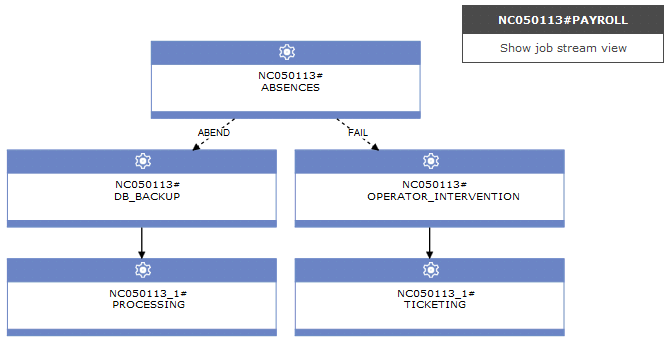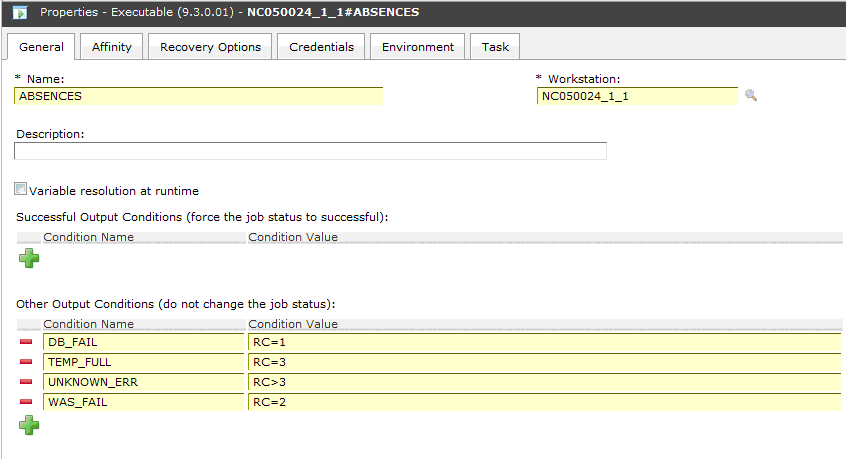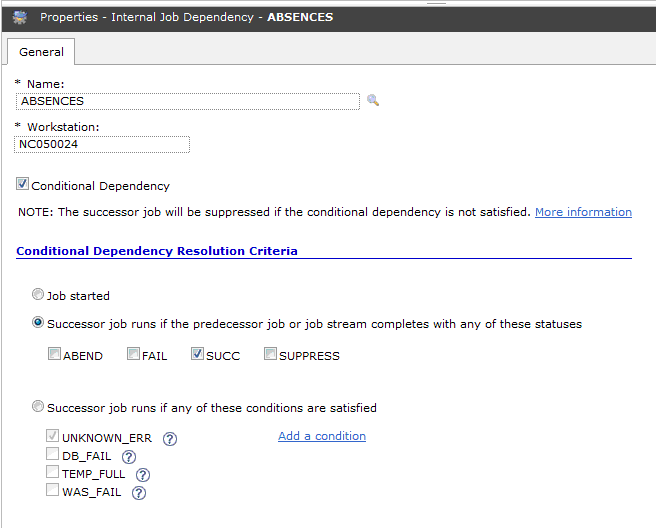Applying conditional branching logic
When specifying dependencies, you can define job flows with alternative branches based on conditions, specifically to achieve the same results as using IF/THEN/ELSE statements. You can use return codes, job status, output variables, and job log content as conditional logic elements to determine the start of a successor job. In addition to providing flexibility to your job flows, the Graphical View provides a graphical representation of the relationships between the jobs and job streams, including the dependencies and conditions. This at-a-glance view of your job flow is easy to read and you can also edit your job flow from this view.
The following example shows the PAYROLL job stream that starts with the ABSENCES job, which is a predecessor job and is then followed by two possible branches of jobs that can run. The branch that runs depends on the outcome of the initial job, the predecessor ABSENCES job. Possible outcomes of the ABSENCES job are defined in output conditions. Any jobs in the flow that do not run, because the output conditions were not satisfied, are put in SUPPRESSED state, which is different from regular dependencies where jobs are put in Hold until the predecessor is in successful (SUCC) state. Predecessors can be either jobs or job streams.

- Status conditions
- These are conditions based on job status, such as if the job started, or if the job completes in FAIL, ABEND, SUCC, or SUPPR state. For job streams, the valid statuses are SUCC, SUPPR, and ABEND.
- Other output conditions
- Other types of conditions, including successful output conditions,
can be specified using a mapping expression, which can be:
- A return code (fault-tolerant and dynamic agents)
- Output variables (dynamic agents)
- Job log content (dynamic agents)

When this job is added to a job stream as a successor job, and a conditional dependency is added to the job preceding this job (predecessor job), then a selection of the conditions is made. The properties panel for the internal or external dependency is dynamically updated to include the conditions originally specified in the job definition. In addition to the conditions originating from the job definition, you can select conditions based on job status. If the selected conditions are satisfied during job processing, then the corresponding successor job runs.

You can also join or aggregate conditional dependencies related to different predecessors. A join contains multiple dependencies, but you decide how many of those dependencies must be satisfied for the join to be considered satisfied. You can define an unlimited number of conditional dependencies, standard dependencies, or both in a join.
Conditional dependencies are supported only for dependencies where the predecessor is a job or a job stream in the same network and where all the components are at least at the Version 9.3 Fix Pack 2 level. They are not supported on internetwork dependencies, nor on Limited Fault-Tolerant Agents for IBM i.